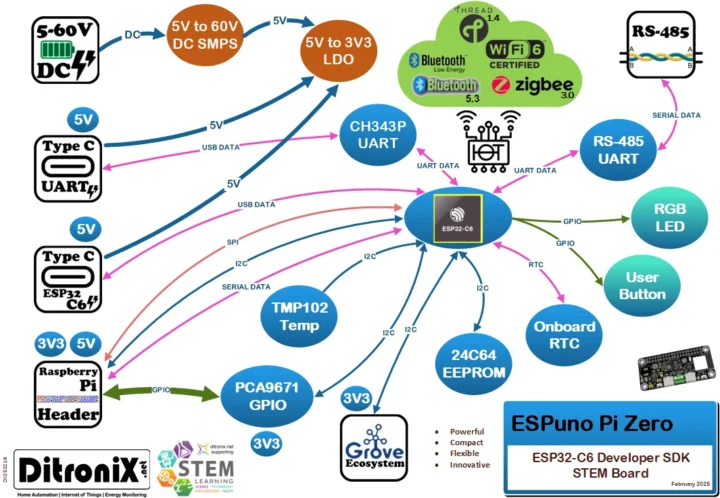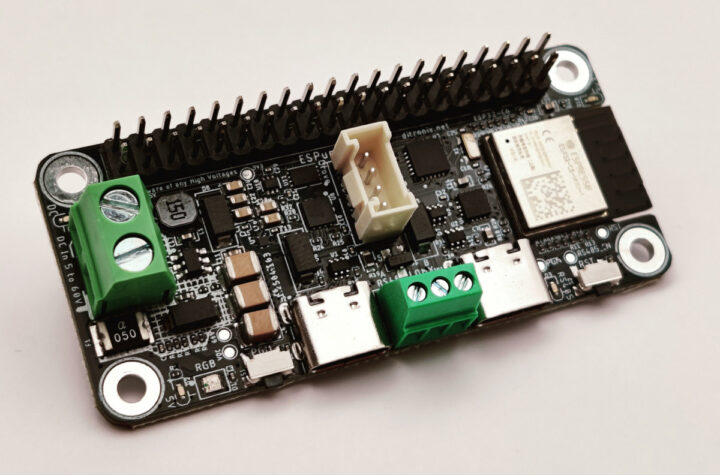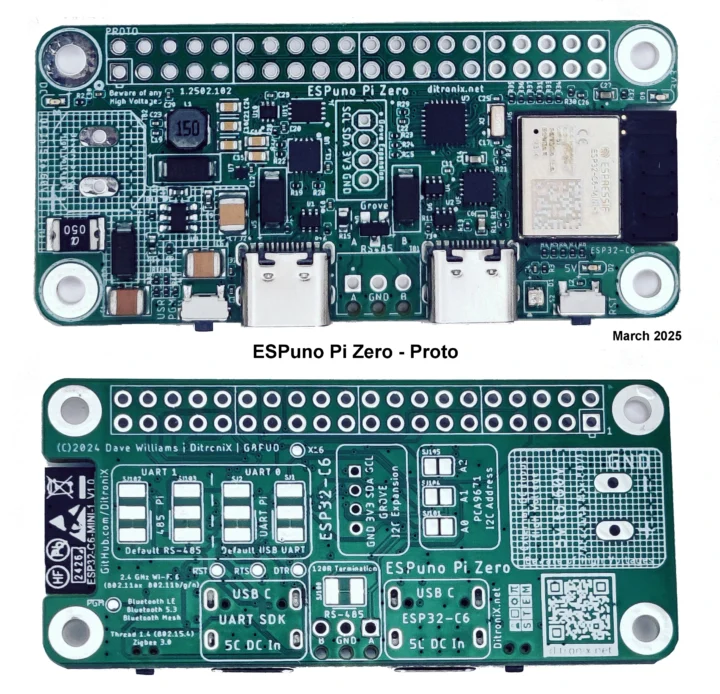ESPuno Pi Zero is a Raspberry Pi Zero-sized board based on an ESP32-C6-MINI-1 WiFI 6, BLE, and 802.15.4 wireless module and an SMPS that allows up to 60V DC input via a 2-pin terminal block.
The board also features two USB-C ports, one connected to the ESP32-C6 and the other to a CH343P USB-to-serial chip, a 40-pin GPIO header, a Grove connector, a 3-pin terminal block for RS-485, DMX, Profibus, and a few buttons and LEDs.
ESPuno Pi Zero specifications:
- ESP32-C6-MINI-1-N4 or ESP32-C6-MINI-1U-N4
- SoC – Espressif Systems ESP32-C6 single-core 32-bit RISC-V clocked up to 160 MHz 320KB ROM, 512KB SRAM, low-power RISC-V core @ up to 20 MHz
- CPU
- Single-core 32-bit RISC-V clocked up to 160 MHz
- Low-power RISC-V core @ up to 20 MHz
- Memory/Storage – 320KB ROM, 512KB SRAM
- Wireless – 2.4 GHz WiFi 6, Bluetooth 5.0, and 802.15.4 radio (for Thread/Zigbee)
- CPU
- Storage – 4MB flash
- Antenna
- ESP32-C6-MINI-1-N4 – PCB antenna
- ESP32-C6-MINI-1U-N4 – External antenna
- SoC – Espressif Systems ESP32-C6 single-core 32-bit RISC-V clocked up to 160 MHz 320KB ROM, 512KB SRAM, low-power RISC-V core @ up to 20 MHz
- Storage – 64Kbit 24C64 I2C EEPROM
- USB
- 1x USB Type-C UART (CH343P) port
- 1x USB Type-C port connected to ESP32-C6
- Expansion
- 40-pin Raspberry Pi-compatible GPIO header via PCA9671 GPIO extender
- 4-pin Grove I2C connector
- 3-pin RS-485 terminal block with support for the DMX512 lighting standard, Modbus, and Profibus
- Misc
- On-board RTC
- Reset and User buttons
- Power LEDs, RGB LED
- Power Supply
- 5V via either USB-C ports
- 5 to 60V DC via 2-pin terminal block for batteries or solar panels
- 5V SMPS 600mA
- 3V3 LDO 700mA
- Dimensions – 65 x 30mm (Raspberry Pi Zero form factor)

DitroniX (Dave Williams) says the board can be programmed with Arduino, CircuitPython, the ESP-IDF framework, PlatformIO, Tasmota, ESPHome, etc… basically the full list of languages, frameworks, and firmware supported by the ESP32-C6. The GitHub repository for the project currently has a few component datasheets, a description of the board, and a code directory with a holder structure for GPIO, Home Automation, RS485, Grove, and radios, but no actual samples just yet.
The board is designed for STEM education for RS485, DMX/DMX512 lighting systems, Modbus RTU control, solar energy monitoring, robotics, drones, and industrial applications. I felt like I had already written about an ESP32 board with 60V DC input, and indeed, the Voidbox FLIP_C3 based on an ESP32-C3 WiFi and BLE module does support up to a 6V to 60V (peak) input range. The ESPuno Pi Zero has a larger design with support for more features and a more powerful ESP32-C6 wireless SoC.
Dave has launched the ESPuno Pi Zero on Kickstarter with a £1000 funding target. Pledges start at £19 (About $26) for the early bird reward with a PCB antenna, and £24 (about $32) with an external antenna. There are also bundles of 5 boards to get better pricing per unit. Shipping adds £4 to the UK and around $5.3 to the rest of the world. Deliveries are scheduled to start in May 2025, right after the crowdfunding campaign ends.

Jean-Luc started CNX Software in 2010 as a part-time endeavor, before quitting his job as a software engineering manager, and starting to write daily news, and reviews full time later in 2011.
Support CNX Software! Donate via cryptocurrencies, become a Patron on Patreon, or purchase goods on Amazon or Aliexpress. We also use affiliate links in articles to earn commissions if you make a purchase after clicking on those links.







No CAN 🙁
Hi randybb,
Appreciate your feedback.
This is the first revision of the ESPuno Pi series and I wanted to keep the board single populated sided, to reduce the profile.
Even using 0201 passives and QFN packages, the board landscape is quite populated and with the HV DC input (which is actually tested up to 80V peak), over-riding safety and thermal zone constraints are very important. Also, balancing fabrication cost through to the end user, comes into play.
Rest assured, the following revisions will have CAN and other exciting features….
If this is a specific area of interest, you are welcome to DM me and happy to share a Beta version, in due course – Q2/3 25
Hope this sort of helps.
Dave
no schematic?